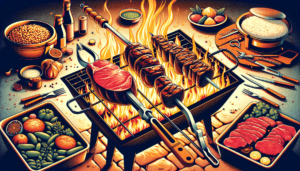Hickory Smoke: A BBQ Essential
Hickory smoke has become a beloved staple in the world of BBQ, infusing meats with a distinctive and mouthwatering flavor that’s hard to resist. This time-honored technique has its roots in Central Texas-style barbecue, where pitmasters have long recognized the magic that hickory imparts to their creations. As we delve deeper into the art of BBQ, you’ll discover the unique benefits of hickory smoke and learn how it contributes to creating some of the best barbecue experiences. From enhancing the natural flavors of meats to adding complexity and depth to your dishes, hickory smoke is a game-changer for BBQ enthusiasts looking to elevate their grilling game.
Types of Hickory Wood for Smoking
Hickory wood is a popular choice for smoking meats, imparting a rich, robust flavor that complements various BBQ dishes. For BBQ enthusiasts looking to elevate their smoking game, understanding the types of hickory wood and proper preparation techniques is crucial.
- Shagbark Hickory: Known for its strong, intense flavor, shagbark hickory is ideal for smoking beef and pork [Source: Smoked BBQ Source].
- Pignut Hickory: This variety offers a milder flavor compared to shagbark, making it versatile for various meats, including poultry and fish.
- Shellbark Hickory: With a flavor profile between shagbark and pignut, shellbark hickory is excellent for all-purpose smoking.
Selecting and Preparing Hickory Wood for BBQ
To ensure you’re getting the best flavor from your hickory wood, follow these preparation tips:
- Look for properly seasoned wood: Ensure the hickory has been dried for at least six months to a year. Well-seasoned wood burns cleaner and produces better smoke [Source: Smoking Meat Forums].
- Choose the right size: For most smokers, chunks (2-4 inches) or split logs work best. Avoid using chips, as they burn too quickly for long smoking sessions.
- Check for mold or insects: Inspect the wood for any signs of decay or pest infestation. Clean, high-quality wood is essential for the best flavor.
Preparing Hickory Wood for Smoking
Here’s how to get your hickory wood ready for your BBQ session:
- Soak or not to soak: Contrary to popular belief, soaking hickory wood isn’t necessary and can actually hinder the smoking process. Dry wood produces cleaner smoke and better flavor [Source: Amazing Ribs].
- Proper storage: Store your hickory wood in a dry, well-ventilated area to prevent moisture absorption and maintain its quality.
- Chip preparation: If using chips for shorter smoking sessions, wrap them in aluminum foil and poke holes to create a smoker packet. This helps control the smoke release.
- Combining woods: Experiment by mixing hickory with fruitwoods like apple or cherry for a more nuanced flavor profile. Start with a 70/30 ratio of hickory to fruitwood and adjust to your taste.
- Preheating: For optimal smoke production, preheat your hickory wood on the firebox before adding it to the main chamber. This helps it start smoking immediately when added to the fire.
By selecting the right type of hickory wood and properly preparing it for your BBQ session, you’ll be well on your way to achieving that perfect smoky flavor in your meats. Remember, practice and experimentation are key to mastering the art of smoking with hickory wood.
The Magic of Smoke: Flavor Chemistry in BBQ
When it comes to crafting the perfect barbecue, understanding the chemistry behind smoke flavor is crucial for every pitmaster. The distinctive taste of smoked meat is a result of complex chemical reactions between smoke compounds and the proteins in your meat.
The key players in this flavor symphony are compounds like guaiacol and syringol, which give BBQ its characteristic smoky aroma. Carbonyl compounds, responsible for the brown color and some of the “roasted” flavors, and organic acids contribute to the overall complexity of the smoke flavor profile.
As you tend to your smoker, here’s how the smoke interacts with your meat:
- Smoke Adhesion: When smoke particles hit the cool surface of the meat, they stick to it, forming a layer known as the pellicle [Source: AmazingRibs.com].
- Penetration: Over time, these smoke compounds slowly penetrate the meat’s surface, infusing it with flavor.
- Chemical Reactions: The heat from your smoker catalyzes reactions between the smoke compounds and the proteins in the meat, creating new flavor molecules.
- Maillard Reaction: This process, which occurs between amino acids and sugars, is responsible for the desirable brown crust (bark) on your brisket or ribs [Source: Serious Eats].
By understanding these chemical interactions, you can fine-tune your smoking technique to achieve that perfect, mouth-watering BBQ flavor that will have your guests coming back for more.
Hickory: The Smoker’s Delight
When it comes to achieving that perfect smoky flavor in your BBQ, hickory wood is a top choice for many pitmasters. But which types of smokers work best with this classic wood, and what tools can help you manage smoke and temperature?
Offset Smokers: The Traditional Choice
Offset smokers, also known as stick burners, are ideal for hickory wood. These smokers allow for excellent smoke control and are perfect for long, slow cooks. The separate firebox lets you add hickory logs or chunks without disturbing the meat, resulting in that deep, rich flavor BBQ enthusiasts crave [Source: Houston Chronicle].
Vertical Water Smokers: Moisture and Flavor
Vertical water smokers work well with hickory chips or chunks. The water pan helps maintain moisture and regulate temperature, while the vertical design allows smoke to circulate evenly. This setup is excellent for achieving that perfect bark on your brisket or pork shoulder.
Pellet Smokers: Convenience Meets Flavor
For those who want convenience without sacrificing flavor, pellet smokers are a great option. Many brands offer hickory pellets, allowing you to infuse your meat with that classic taste while benefiting from the set-it-and-forget-it nature of these smokers.
Kamado Grills: Versatile and Efficient
Ceramic kamado grills, like the Big Green Egg, are versatile and work exceptionally well with hickory. Their excellent heat retention and airflow control make them ideal for both low-and-slow smoking and high-heat grilling.
Tools for Managing Smoke and Temperature
- Digital Thermometers: Invest in a good quality digital thermometer with multiple probes. This allows you to monitor both the smoker temperature and the internal temperature of your meat simultaneously.
- Temperature Controllers: For more precise control, consider a temperature controller like the BBQ Guru or Flame Boss. These devices regulate airflow to maintain a steady temperature, which is crucial when using hickory wood.
- Smoke Tubes: If you want to add extra hickory smoke to any type of grill or smoker, a smoke tube is an excellent accessory. Fill it with hickory pellets for an additional boost of smoky flavor.
- Chimney Starter: For offset smokers, a chimney starter helps you quickly light charcoal or wood chunks, ensuring a clean burn and reducing the chance of bitter creosote buildup.
- Drip Pans: Use aluminum drip pans to catch drippings and help regulate temperature. They can also be filled with water or other liquids to add moisture and flavor to your cook.
Remember, when using hickory, a little goes a long way. Start with small amounts and adjust based on your taste preferences. With the right smoker and tools, you’ll be well on your way to mastering the art of hickory-smoked BBQ [Source: CBS News].
Mastering the Art of Smoking: Essential Techniques for BBQ Enthusiasts
Preparing your smoker is the first crucial step in achieving BBQ perfection. Start by thoroughly cleaning your smoker, removing any ash or debris from previous uses. Next, season your smoker by coating the interior with a thin layer of cooking oil and running it at high temperature for about an hour. This process helps prevent rust and improves flavor over time [Source: AmazingRibs.com].
Controlling smoke intensity is key to achieving the perfect flavor profile. For a milder smoke flavor, use fruitwoods like apple or cherry. For a stronger taste, opt for hickory or mesquite. Start with 2-3 chunks of wood for most meats, adding more gradually if needed. Remember, it’s easier to add smoke than to remove it, so start conservatively [Source: Smoked BBQ Source].
Maintaining ideal temperature is crucial for consistent results. Most meats smoke best between 225°F and 250°F. Use a reliable digital thermometer to monitor both the smoker’s internal temperature and the meat’s temperature. For longer smokes, consider using the “snake method” for charcoal arrangement, which provides a steady burn for up to 12 hours [Source: The Virtual Weber Bullet].
Monitoring meat progress ensures perfectly cooked BBQ every time. Invest in a good quality probe thermometer that can be left in the meat throughout the smoking process. For most cuts, aim for an internal temperature of 195°F to 205°F for optimal tenderness. Remember that larger cuts like brisket or pork shoulder will experience a “stall” phase where the temperature plateaus – this is normal and requires patience [Source: Smoking Meat Forums].
By mastering these techniques, you’ll be well on your way to smoking mouth-watering BBQ that will impress even the most discerning pitmasters. Remember, practice makes perfect, so don’t be discouraged if your first attempts aren’t flawless – each smoke is an opportunity to refine your skills and create something delicious.
Hickory Smoke: Enhancing Different Meats
Hickory smoke imparts a rich, bold flavor that’s become synonymous with classic barbecue. Its distinctive taste is characterized by a robust, savory profile with subtle sweet undertones, making it a favorite among BBQ enthusiasts. The aroma of hickory smoke is equally captivating, filling the air with a strong, earthy scent that’s sure to make mouths water.
Here’s how hickory smoke enhances various types of meat:
- Beef: Hickory’s strong flavor stands up well to beef, especially brisket and ribs. The smoke penetrates the meat, creating a delicious bark and infusing the beef with a deep, complex flavor [Source: Houston Chronicle].
- Pork: For pork shoulders and ribs, hickory smoke adds a robust flavor that complements the meat’s natural sweetness, particularly effective for creating that sought-after “pulled pork” taste.
- Poultry: While hickory can be used with chicken and turkey, it’s best applied moderately to avoid overpowering delicate meats. Try mixing hickory with a milder wood like apple for a balanced flavor profile.
- Fish: For hearty fish like salmon, a light application of hickory smoke can add depth without overwhelming the natural flavors.
To achieve the best results with hickory smoke, start with quality wood, control the smoke, and make use of rubs. Experiment with blends and bear in mind that the key to mastering hickory smoke is practice and patience.
Mastering the Art of Smoke: Avoiding Over-Smoking and Balancing Flavors
Over-smoking is a common pitfall for BBQ enthusiasts, but with the right techniques, you can achieve that perfect balance of smoky goodness and natural flavors. To prevent over-smoking, start by using the right amount of wood. Less is often more when it comes to smoke [Source: CNET]. Begin with a small amount of wood and add more gradually if needed.
Timing is crucial in avoiding over-smoking. Most meats absorb smoke more readily in the first few hours of cooking. After this period, you can wrap your meat in foil or butcher paper to prevent further smoke absorption while allowing it to continue cooking.
To balance smoke with other flavors, choose complementary wood types, use a balanced rub, experiment with sauces, and consider beverage pairings. These steps will go a long way in refining your BBQ offerings, ensuring a harmonious and flavorful dining experience.
Creating Unique Flavor Profiles: The Art of Wood Pairings for BBQ
For BBQ enthusiasts looking to elevate their grilling game, mastering the art of wood pairings is essential. Different woods can impart unique flavors to your meats, creating complex and delicious taste profiles. Here’s how to pair woods for unforgettable BBQ experiences:
- Fruity and Mild: Combine apple and cherry woods for a subtle, sweet flavor that pairs excellently with pork and poultry.
- Bold and Robust: Mix hickory and oak for red meats like beef brisket or ribs.
- Sweet and Nutty: Blend maple and pecan woods for a unique sweet and nutty profile.
- Savory and Aromatic: Combine mesquite wood chips with sprigs of fresh rosemary for an adventurous flavor profile.
- Balanced and Versatile: Pair oak with fruit woods like apple, cherry, or peach for a balanced flavor.
Experiment with these wood combinations, and you’ll be able to create unique flavor profiles that will set your BBQ apart.
Conclusion: Embark on Your BBQ Journey
Mastering the art of BBQ is a journey of continuous learning and experimentation. As we’ve explored, the key to great barbecue lies in understanding your equipment, selecting quality ingredients, and perfecting your techniques. Remember, barbecue is deeply rooted in tradition, but there’s always room for innovation.
To recap the essential points:
- Equipment matters: Invest in a reliable smoker or grill that suits your needs.
- Quality ingredients: Start with the best meats and seasonings you can afford.
- Temperature control: Master the art of maintaining consistent heat throughout the cook.
- Patience is key: Great barbecue takes time, so don’t rush the process.
- Experiment with flavors: Try different rubs, woods, and sauces to find your signature style.
Now, it’s time to put these lessons into practice. Don’t be afraid to experiment with new techniques or flavor combinations. As Mark Black, a renowned pitmaster, says, “I think (barbecue) is one of the best food cities in the United States; it’s so diverse.” This diversity is your playground for culinary creativity.
Remember, perfecting your craft takes time and practice. Each BBQ session is an opportunity to learn and improve. Whether you’re smoking brisket, grilling ribs, or trying out new sauces like Pearson’s Premium Gourmet BBQ Sauce, embrace the process and enjoy the journey.
Keep exploring different regional styles, attend barbecue festivals, and don’t hesitate to share techniques with fellow enthusiasts. Your next cookout could be the one where you discover your signature dish or perfect that elusive smoke ring.
So fire up that grill, gather your friends and family, and let your passion for great barbecue shine through. With dedication and a willingness to learn, you’re well on your way to becoming a true BBQ master. Happy grilling!
Sources
AmazingRibs.com – How to Set Up a Charcoal Grill or Smoker
Amazing Ribs – Myth: Soak Your Wood First
AmazingRibs.com – What You Need to Know About Wood Smoke and Combustion
CBS Colorado – Enjoy Some of the Best Barbecue in Colorado at GQUE BBQ
CBS News – Pearson’s Premium Gourmet BBQ Sauce
CNET – 9 Mistakes You May Be Making with Your Air Fryer
Forbes – Seven Red Wines from Five Italian Regions to Sample During February
Houston Chronicle – Terry Black’s Barbecue: Houston’s Hotel
Food Chemistry Journal – An Analysis of BBQ Methods
Serious Eats – The Food Lab: Complete Guide to Sous Vide Barbecue
Smoked BBQ Source – Smoking Wood




